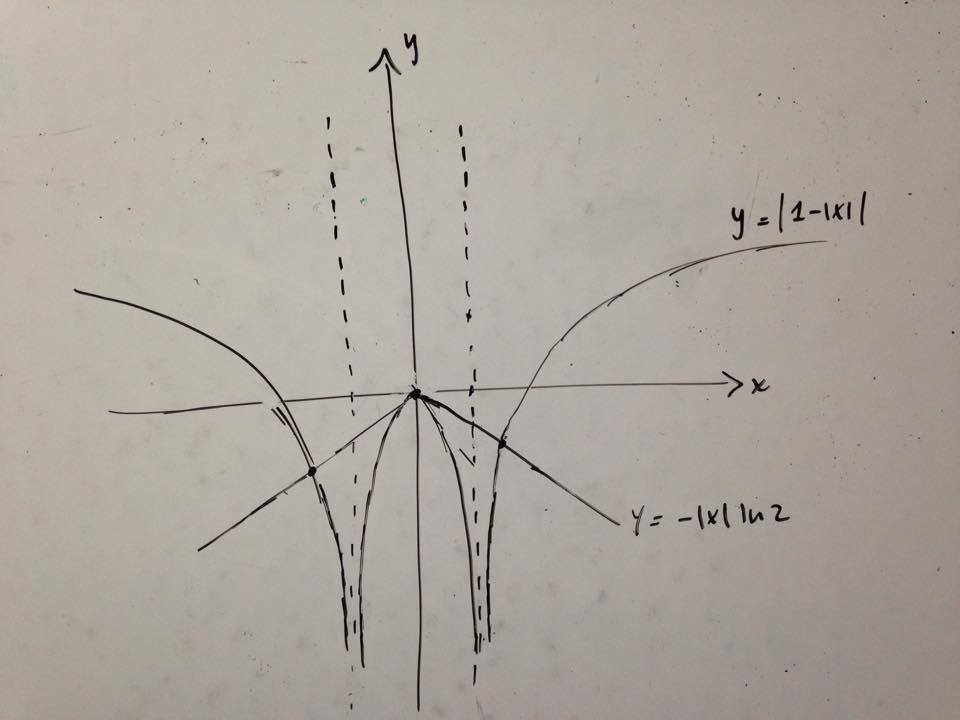Too many vertical lines
Find the number of real solutions of x that satisfy
2 ∣ x ∣ ∣ ∣ ∣ ∣ 1 − ∣ x ∣ ∣ ∣ ∣ ∣ = 1 .
The answer is 3.
This section requires Javascript.
You are seeing this because something didn't load right. We suggest you, (a) try
refreshing the page, (b) enabling javascript if it is disabled on your browser and,
finally, (c)
loading the
non-javascript version of this page
. We're sorry about the hassle.
6 solutions
Making a rough graph too would give the same results
Taking the natural logarithm on both sides of the given equation gives us
( ∣ x ∣ ln 2 ) ( ln ∣ 1 − ∣ x ∣ ∣ ) = 0
which means that ∣ x ∣ = 0 or ln ∣ 1 − ∣ x ∣ ∣ = 0 . It is clear that ∣ x ∣ = 0 if x = 0 , and that ln ∣ 1 − ∣ x ∣ ∣ = 0 if x = 0 , 2 , − 2 , so our solution set is { 0 , 2 , − 2 } .
How does 2 is a solution? I mean, 2^2(2-1)=1 doesn't seem true
You solved the equation that you wrote just fine, but it is not consistent with the given equation. Taking the natural log of both sides will give ln ( 2 ∣ x ∣ ∣ 1 − ∣ x ∣ ∣ ) = 0
Which, when expanded becomes
∣ x ∣ ln 2 + ln ∣ 1 − ∣ x ∣ ∣ = 0
isn't this wrong
2 can't be solution
ln(1-|x|), becomes undefined
Log in to reply
It would be wrong if what you have written was in the equation the Jake Lai wrote. The argument of natural log in the equation is ∣ 1 − ∣ x ∣ ∣ . When positive or negative 2 is plugged in for x you get ∣ − 1 ∣ = 1 for the argument of natural log.
ln a b = ln a + ln b = l n a ⋅ l n b
We can rewrite the original equation, according to the rules of logarithms, to ge the following: ln ∣ ∣ 1 − ∣ x ∣ ∣ ∣ = − ∣ x ∣ ln 2
By using transformations of graphs, we can sketch a rough graph for the funcions on each side of the equation:

Here the number of intersections of both graphs gives the number of solutions. Now, for there to be more than 3 solutions (i.e. 5), we would require that the gradient of our line y = − ∣ x ∣ ln 2 is greater (in absolute value) than the gradient (in absolute value) of the tangent to y = ln ∣ ∣ 1 − ∣ x ∣ ∣ ∣ at the origin, which we can find to be 1 using calculus (assuming that the funcion is differentiable at this point). Since the gradient of our line is ln 2 < 1 , we know that there's only 3 solutions to the equation.
Graph of 2^x and jigsaw pattern of 1-x will yield 3 intersections
Since the LHS is an even function, in suffices to consider x ≥ 0 , by symmetry.
For x ≥ 1 , the function f ( x ) = 2 x ( x − 1 ) is increasing to infinity, with f ( 1 ) = 0 , so that there is exactly one solution, c , by the intermediate value theorem.
For 0 ≤ x ≤ 1 , the function g ( x ) = 2 x ( 1 − x ) is decreasing (the derivative is negative), so that g ( 0 ) = 1 is the only solution.
Thus we have 3 solutions all together, c , − c and 0.